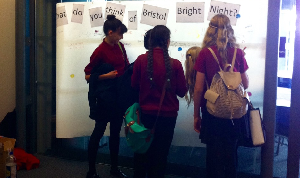Blog Archives
Tackling the challenge of engaging with drought and frogs
SCU was well represented at the Bristol Festival of Nature (BFON) in June, with Associate Professor Emma Weitkamp manning the Drought Risk and You (DRY) stand on Saturday and MSc student Hannah Conduit showcasing her research with the Durrell Trust as part of UWE’s festival tent.
 Emma is exploring communication and engagement barriers and enablers related to drought and water scarcity within the DRY project. At BFON, Emma was interested to hear what visitors think about a set of cartoons produced as part of the project and whether these might be a tool to open conversations about water scarcity; climate change models suggest the UK will have wetter winters and drier summers, increasing the risk that we will have serious droughts. . In the southern UK, the most severe in living memory is the drought of ’76.
Emma is exploring communication and engagement barriers and enablers related to drought and water scarcity within the DRY project. At BFON, Emma was interested to hear what visitors think about a set of cartoons produced as part of the project and whether these might be a tool to open conversations about water scarcity; climate change models suggest the UK will have wetter winters and drier summers, increasing the risk that we will have serious droughts. . In the southern UK, the most severe in living memory is the drought of ’76.
Initial work within the DRY project highlights the challenges of engaging people with Drought. Unlike flooding which has immediate effects, drought has a slow onset and many not have immediate relevance to many people. Rain during BFON highlights the challenge – how do you engage people with drought when it’s raining?

Emma Weitkamp and DRY Project leader Lindsey McEwen at the DRY stand, Bristol Festival of Nature
Emma presented initial work on citizen science aspects of the DRY project at the Society for Risk Analysis meeting in Bath, 20th June, while Adam Corner, of Climate Outreach presented the project’s initial work on communication barriers.

Jeff Dawson with the project research tools
Frogs are not the cuddliest of species, so Hannah is tackling similar challenges through her research with the Durrell Trust. Amphibians have suffered a dramatic decline in numbers, and around 40% of all amphibian species are now considered to be under threat. But in a world of glamorous tigers and cuddly lemurs, it is sometimes hard for frogs to get a look in.
Hannah’s research focuses on one particular species of frog; second largest in the world and perhaps one of the most endangered. The ‘Mountain Chicken’ is aptly named for its meat; prised locally as a delicacy with taste and consistency similar to that of its feathery cousin.
With less than 100 individuals remaining in the wild and continued threat from disease, the Durrell Trust and UWE are working together to find more effective ways of communicating the plight of amphibians like the Mountain Chicken.
At BFON, Hannah and her Durrell supervisor, Jeff, along with a small group of volunteers talked with the public about the Mountain Chicken’s story, as well as showing them some of the methods used by scientists and researchers to monitor the remaining wild frogs. Scanning the stall’s microchipped frog plushies and swabbing them for a fungal disease called Chytrid proved to be the weekend’s most popular activities.

Erik Stengler, Hannah Conduit and Jeff Dawson, at the Saving the Mountain Chicken Frog stand, Bristol Festival of Nature
Research is currently ongoing for Hannah’s project, and will culminate in a handbook for use by the Mountain Chicken Recovery Programme in raising awareness and gathering interest amongst the public for the species.
Blog post written by Emma Weitkamp & Hannah Conduit
Bristol Bright Night summary
 On Friday 25th September 2015 Bristol was one of the many European cities celebrating research and researchers. The European Researchers’ Night takes place every year, on the last Friday in September. The event is known locally as Bristol Bright Night and it’s jointly organised by UWE Bristol, the University of Bristol and the Bristol Natural History Consortium.
On Friday 25th September 2015 Bristol was one of the many European cities celebrating research and researchers. The European Researchers’ Night takes place every year, on the last Friday in September. The event is known locally as Bristol Bright Night and it’s jointly organised by UWE Bristol, the University of Bristol and the Bristol Natural History Consortium.
 Running for the second year, Bristol Bright Night offered an array of activities including talks, hands-on, debates, comedy and many others. Margarida Sardo from UWE Science Communication Unit was responsible for evaluating the event. The evaluation was designed to suit different venues and audiences.
Running for the second year, Bristol Bright Night offered an array of activities including talks, hands-on, debates, comedy and many others. Margarida Sardo from UWE Science Communication Unit was responsible for evaluating the event. The evaluation was designed to suit different venues and audiences.
For this event the methods used included paper and online questionnaires (using an ipad didn’t work very well!), observations, a feedback wall – which was particularly popular with school children – and post-event interviews with researchers and organisers.
For more photos from the event, go to the BNHC website.
Student opportunities at the Latitude Festival
One of the nice things we’re able to do from time to time is offer our Masters students work experience on a public engagement project.
For the last two years (2014 and 2015) Margarida Sardo and I have carried out an evaluation of a strand of activities sponsored by the Wellcome Trust at the annual Latitude Festival.
The Latitude Festival is a well-known and wide-ranging cultural festival, which includes comedy, music, theatre, literature, poetry, dance and more (think Glastonbury but with less mud and more writers!). The Wellcome Trust events are also hugely varied, including poetry, music and theatre performances, presentations, discussions, dialogues and interactive events.
Margarida designed the evaluation, including snapshot interviews with members of the audiences, informal feedback via comment cards, observations of events and interviews with presenters, while I led the evaluation at the festival. In both years, the students were chiefly responsible for carrying out the audience interviews and looking after the informal feedback, so it was an excellent opportunity to gain an understanding of what is involved in the evaluation of a live event as well as strengthen their communication skills.
With around 26 events taking place in half a dozen locations around the three days of the Festival, the help and support of our students was absolutely invaluable in helping to collect as much data as possible. Between them, the 2015 team observed 14 full events, persuaded 45 people to be interviewed and got 192 people to complete a comment card!
In return for students’ support, we offered a modest payment, subsistence expenses during the Festival and free transport to and from Suffolk. The students also had free tickets to the Festival, which gave them access to most of its 200 or so events. As most of the science events took place during the day, and the big comedy and music headliners were on late at night, the students got to see some really interesting stuff!
You can find our report from the 2014 Festival on the UWE repository. And the hard work of the students is also contributing to two papers that Margarida and I are currently working on.
Ann Grand and Margarida Sardo are research fellows in the Science Communication Unit.
Knowledge is power?
Research shows that audiences at a health science festival prefer lectures.
We all know the debates about deficit versus dialogue, but what do audiences prefer? This was the central research question in my recent study looking at a health science festival in New Zealand.
Science festivals offer an interesting environment to explore preferences for format design, as they usually feature a huge variety of different event styles. The science festival in question was held in Auckland, New Zealand, and focussed on health science research around the brain and psychology. Held as part of international Brain Awareness Week, ‘Brain Day’ attracts over 3000 people to this free one-day annual event- not an insignificant number in a country of just 4.5 million people!
The festival formats under question were lectures, discussions, a community expo, laboratory experiments and a general good day out. Festival entrants were handed a questionnaire to fill in, and could return it anonymously to a drop-box at the exits, with a prize draw incentive. The experiment was repeated over three years, and in total we reached a sample of 661 people.
So which format did they prefer? Overwhelmingly, this sample significantly preferred lectures; with 76% ranking them the main attraction, 89% attending them, and 84% stating lectures were the most useful. This was irrespective of age, gender, education, or the year the festival was run. In open response questions participants described their reasons – stating that ‘knowledge is power’. Participants were attending the festival to learn something new, and lectures presented a good way to hear about research and expert opinion.
But wait – don’t throw the baby out with the bathwater! We conclude that all formats have a part to play in the science communication landscape. Over two-thirds of the sample visited more than one format, and indeed, laboratory experiments were the second choice for family visitors. Yet however you look at it, the much derided format of lectures is still clearly popular with audiences.
Laura Fogg-Rogers is a Research Fellow in the SCU at UWE.
@laurafoggrogers
This post was originally published in the STEM Communicators Network newsletter Issue 32.The research article it is based on is available in Science Communication 37 (4).





